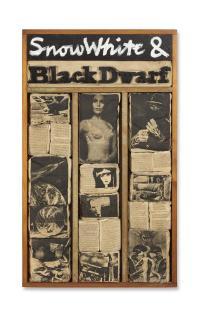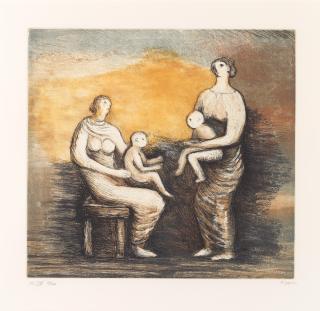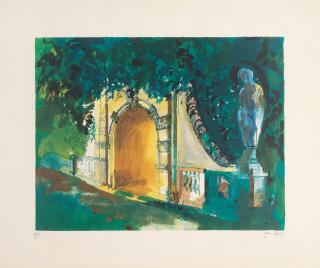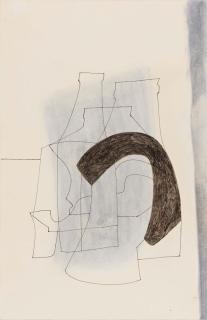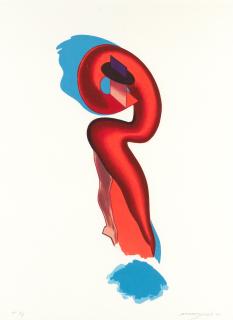Joe Tilson British, born 1928
The artist Joe Tilson
- Important representative of British Pop Art.
- Combination Pictures characterise his style.
- Member of the Royal Academy of Arts.
Joe Tilson, born 24.08.1924 in London, is an important representative of British Pop Art. Characteristic for his works is the play with the language of signs. His so-called Combination Pictures combine symbols and iconic signs to create a synthesis of the arts. Some of his pictures, for example, are divided into lurid, richly coloured squares, rhomboids or bars and are decorated with meaning-laden signs such as hearts, hands or eyes as well as with letters of various alphabets and numbers.
The symbols are often taken from classical mythology or Neo-Platonism, while the colouring is often kept simple, as is typical of Pop Art. Before devoting himself to art, Tilson worked as a carpenter. At the end of the 1940s, he finally began studying at St Martin's School of Art in London, where he was taught by Leon Kossoff and Frank Auerbach, among others. This was followed by studies at the Royal College of Art, also in London.
There he won a scholarship in the 1950s, the prestigious Rome Prize, which enabled him to travel to Rome – where he stayed until 1957. In 1961, his works were shown at the Biennale de Paris and only a year later, the Marlborough Gallery in London dedicated his first solo exhibition to him. A pavilion at the 32nd Venice Biennale followed in 1964, and four years later he participated in documenta 4.
In the 1970s he was a guest lecturer at the Hochschule für Bildende Künste in Hamburg for a year. Today, Tilson's paintings belong to the collections of the Tate Gallery in London and the Museum of Modern Art in New York, among others. Tilson has been a member of the Royal Academy of Arts since 1991.
Der Künstler Joe Tilson
- Bedeutender Vertreter der britischen Pop-Art.
- Combination Pictures prägen seinen Stil.
- Mitglied der Royal Academy of Arts.
Joe Tilson, geb. 24.08.1924 in London, ist ein bedeutender Vertreter der britischen Pop-Art. Charakteristisch für seine Werke ist das Spiel mit der Zeichensprache. Seine sogenannten Combination Pictures vereinen Symbole und ikonische Zeichen zu einem Gesamtkunstwerk. So sind einige seiner Bilder in grelle, sattgefärbte Quadrate, Rauten oder Balken aufgeteilt und mit bedeutungsaufgeladenen Zeichen wie Herzen, Händen oder Augen sowie mit Buchstaben verschiedener Alphabete und Zahlen versehen.
Die Symbole entspringen dabei häufig der klassischen Mythologie oder dem Neuplatonismus, während der Kolorit Pop-Art-typisch oft einfach gehalten ist. Bevor Tilson sich der Kunst widmete, war er als Zimmermann tätig. Ende der 1940er-Jahre nahm er schließlich ein Studium an der St Martin's School of Art in London auf und hatte dort u. a. Leon Kossoff und Frank Auerbach als Lehrmeister.
Anschließend folgte ein Studium am Royal College of Art, ebenfalls in London. Dort gewann er in den 1950er-Jahren ein Stipendium, den renommierten Rom-Preis, das es ihm ermöglichte, nach Rom zu reisen – dort hielt er sich bis 1957 auf. 1961 wurden seine Werke auf der Biennale de Paris gezeigt und nur ein Jahr später widmete ihm die Marlborough Gallery in London seine erste Einzelausstellung. 1964 folgte ein Pavillon auf der 32.
Biennale von Venedig, vier Jahre später die Teilnahme an der documenta 4. In den 1970er-Jahren war er für ein Jahr Gastdozent an der Hochschule für Bildende Künste in Hamburg. Heute gehören Tilsons Bilder u. a. in die Sammlungen der Tate Gallery in London und des Museum of Modern Art in New York. Seit 1991 ist Tilson Mitglied der Royal Academy of Arts.


















